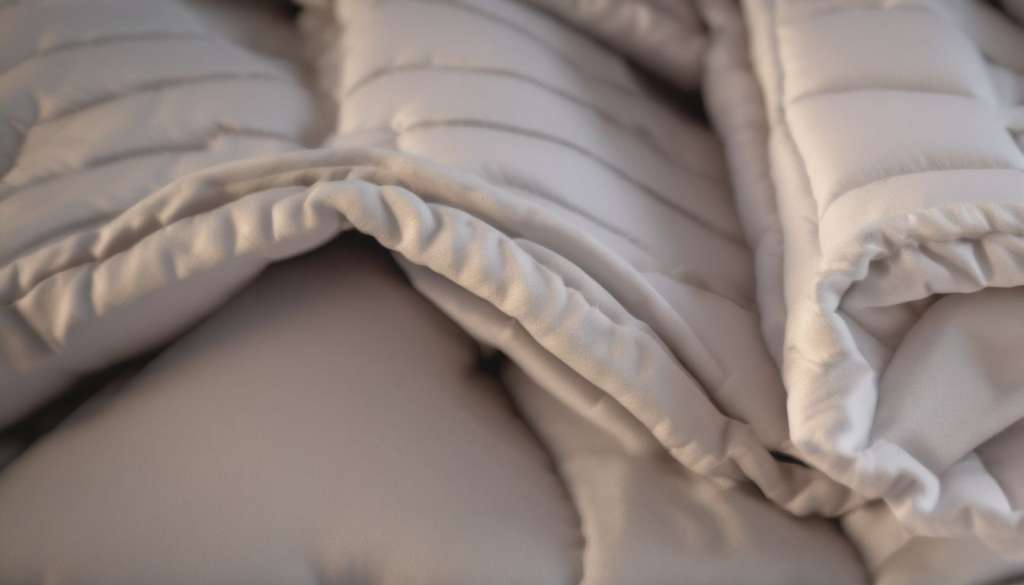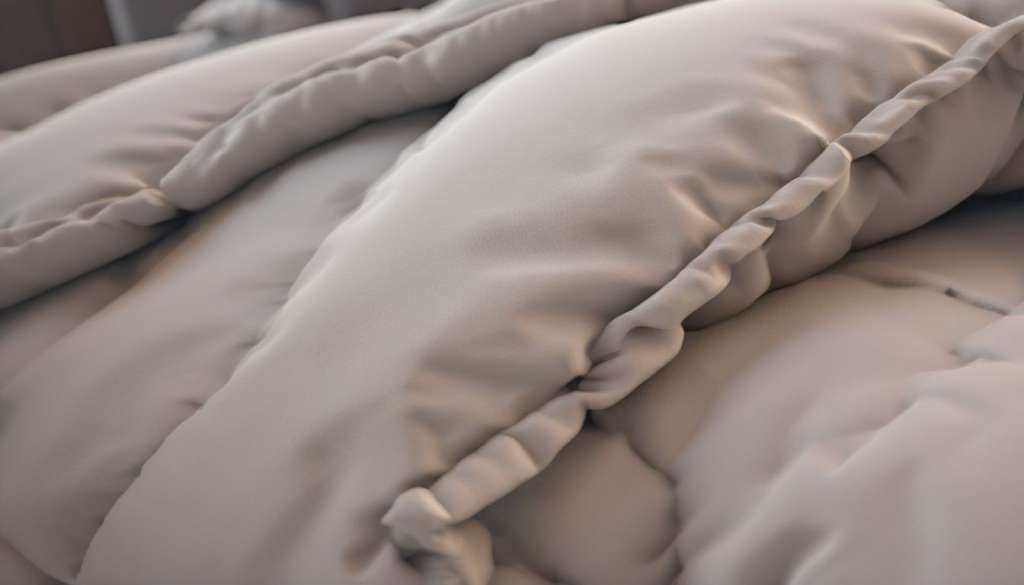Do you love snuggling under your down-filled comforter during cold winter nights? Over time, these cozy bedding accessories can lose their bright white sheen and turn an unappealing shade of yellow.
What causes this yellowing effect in down comforters? And more importantly – how can you stop it from happening in the first place? This comprehensive guide will teach you everything you need to know.
What Is a Down Comforter?
Before we dive into the yellowing issue, let’s review what exactly a down comforter is.
A down comforter is a type of duvet or quilt filled with duck or goose down feathers. The outer shell encasing the down fill is usually made from fabrics like cotton, cotton sateen, or Egyptian cotton.
Down comforters are valued for attributes like:
- Exceptional warmth
- Lightweight breathability
- Delicate softness against skin
- Long-lasting durability
Why Do Down Comforters Turn Yellow Over Time?
When cared for properly, a high quality down comforter can last over a decade. But after continuous use, most lose their bright white color and fading to an unappealing yellowish-tan.
So what causes this yellowing effect?
There are a few key culprits behind down comforter discoloration:
Body Oils and Sweat
Your body naturally produces oils and sweat while you sleep. These substances seep into the down through the shell fabric overtime. The moisture causes the filling to clump and discolor.
Environmental Factors
Elements like sunlight, pollution, and humidity can weaken fabrics over time. This leads to exterior yellowing on the shell.
Improper Cleaning
Harsh laundry detergents, hot water, and excessive drying slowly strip the oils from down feathers. This oxidation causes dullness and yellowing internally.
Types of Down Comforters
While all down comforters can experience fading, premium down alternative comforters tend to show much less discoloration over time.
Here’s an overview of the two main types and their attributes when it comes to yellowing:
The durable synthetic fill makes down alternatives more colorfast against fading elements like sunlight and oxidation. Plus, the special antimicrobial treatment helps prevent bacteria buildup from sweat and oils.
Anatomy of a Down Comforter’s Construction
Aside from the type of filling, the shell fabric also impacts a down comforter’s susceptibility to yellowing.
Here are the key structural elements of quality construction:
- Cotton Shell with Long-Staple Cotton: High-end 300-thread count or higher cotton woven from extra long cotton fibers. More durable and breathable.
- Diamond-Quilted Pattern: Prevents the fill from shifting and clumping over time.
- Corner Loops/Tabs: Allow you to secure a duvet cover over the comforter.
- Double Needle Edge Stitching: Creates a clean finish that prevents down leakage through weak seams.
The better the structural integrity, the less wear and tear occurs – leading to less discoloration.
Tightly-woven, high grade shell materials create an effective moisture barrier against oils and sweat. Plus, a securely constructed fill compartment keeps down feathers evenly distributed rather than clumping. This prevents moist oxidation over time.

Environmental & Usage Factors Accelerating Discoloration
Aside from the materials and construction themselves, your usage habits and environmental elements affect how quickly a down comforter fades to yellow.
Bedding Habits
Using additional layers along with your down comforter speeds up discoloration:
- Duvet covers: Trap body oils, sweat and moisture against the shell. Choose breathable, lightweight covers that can be washed frequently.
- Extra bedding layers: Adding mattress pads, blankets or flat sheets underneath creates excess warmth that increases sweat. Keep your setup simple with just a fitted sheet beneath your comforter.
Environmental Elements
Environmental elements that strain the shell fabric lead to exterior yellowing:
- Sunlight & pollution: UV exposure weakens fabric dyes and fibers. Keep your blinds/curtains drawn during peak daylight hours.
- Humidity: Moisture encourages mildew growth which stains the shell yellowish over time. Make sure you have adequate ventilation and air circulation. Use a dehumidifier if needed.
Here’s a comparison of environmental factors on fading rate:
| Element | Impact Level |
|---|---|
| Sunlight | High |
| Pollution | Medium |
| Humidity | Medium |
As you can see, sunlight and pollution have the biggest effect. So proper window coverings are critical for preservation.
How Material Quality Impacts Yellowing
The quality and properties of both the shell fabric and down fill significantly influence fading rate.
Shell Fabric
- Hypoallergenic Materials: Naturally repel dust mites and allergens that cause clumping of down and discoloration over time.
- Breathability: Allows moisture vapor to evaporate quickly rather than getting trapped internally. Look for moisture wicking materials like PrimaLoft fibers.
Filling
- Softness Level: Softer down clusters have finer fibers that cling together when compressed. This causes clumping and uneven off-white tones.
- Cleaning Ease: Lower-grade down requires special chemical solvents to thoroughly clean oils and grime trapped deep within clusters. Residue causes dullness.
Higher-end down alternative fills avoid these issues with advanced fiber technologies specifically engineered for retention of loft and colorfastness.
Proactive Prevention: Design & Care Tips
While some discoloration is inevitable over years of use, you can take key steps to dramatically slow the rate of yellowing on your down comforter.
Choosing Design Elements
Opt for styles and materials that better withstand environmental strains:
- Pre-washed bedding: The factory washing process removes excess down oils and dander that cause early clumping.
- Solid colors over patterns: Decorative prints use thinner, weaker dye layers more vulnerable to UV fading.
- Custard yellow over bright white: Warm neutral yellows retain their color better than stark whites against yellowing agents.
Proper Care Between Wash Cycles
- Air Out: Allowing moisture evaporation prevents musty smells and staining.
- Spot clean stains: Use a diluted, hydrogen peroxide-based spray before stains have a chance to set.
- Avoid excessive heat: High temperatures speed up material degradation over time.
Best Practices for Washing Down Items
- Top-loader washing machines: The central agitator is gentler on down clusters than front-loader tumbling.
- Mild detergent: Harsher chemicals strip protective oils leading to dullness. Use an extra rinse cycle to remove all soap residue.
- Low heat drying: High temperatures cook feathers causing brittleness, shrinking and yellowing. Use air fluff or no heat setting.
Care label guidelines take priority for your specific comforter model.
Here is a comparison chart summarizing key care differences between down and down alternative comforters:
| Care Step | Down Comforter | Down Alternative Comforter |
|---|---|---|
| Washing | Gentle cycle in large commercial machines | Can be washed in home machines |
| Drying | Air dry flat for 24+ hours | Machine dry low heat |
| Stain Removal | Professional dry cleaningusually needed | Spot treat with hydrogen peroxide solutions |
Down alternatives can withstand much more vigorous home laundry care without damage.
Final Takeaways on Preventing Down Comforter Yellowing
To wrap things up, be sure to:
- Select down alternative fills over natural down for better color retention
- Choose high-grade shell materials like cotton sateen or PrimaLoft fibers
- Wash using mild detergent on a delicate cycle with an extra rinse
- Air dry completely flat before storage or re-use
- Avoid excessive heat, humidity and light exposure which accelerate fading
Properly caring for your down bedding helps retain that dreamy cloud-like warmth you love while maintaining a beautiful white aesthetic for years to come.
For more guidance, check out this comprehensive care guide for down comforters by American Down & Feather Council.
Now that you know what causes yellowing and how to fight it, you can keep your down bedding looking freshly fluffy and bright season after season!

Frequently Asked Questions
Why does my down comforter have a yellow tinge after washing?
Excessive heat, harsh detergents and insufficient rinsing during washing can remove the protective oils covering down feathers. This oxidation causes dullness and yellow discoloration. Be sure to use mild detergent and wash on a delicate cycle in cool water. Rinse twice to eliminate all soap residue.
How do I make my yellowed down comforter white again?
For minor yellowing, try washing with an oxidizing cleaner like oxy powder or sodium percarbonate to lift stains safely. For advanced discoloration, you’ll need professional dry cleaning using chemical solvents to fully extract embedded oils and revitalize whiteness. White vinegar or lemon juice can also help brighten during home washing.
Should I line dry or machine dry my down comforter?
Always air dry down comforters naturally rather than machine drying. High heat degrades feathers causing brittleness, shrinking and yellowing over time. Lay flat for 24-48 hours allowing all moisture to fully evaporate before use or storage. This preserves loft and prevents odor issues.
How often should you wash a down comforter?
Only wash down comforters 1-2 times per year at max. Frequent washing strips away protective down oils leading to drying, clumping and accelerated discoloration. Use a duvet cover to protect your comforter from body oils between washes. Spot clean stains as needed with hydrogen peroxide spray.
What is the best color to prevent a comforter from looking dirty?
Choose ivory, cream or light tan comforters rather than bright white. Warm neutral shades hide soiling much better than stark white against yellowing elements like body oils, light exposure and humidity over time. Plus, colored down bedding retains its original hue longer before fading.








